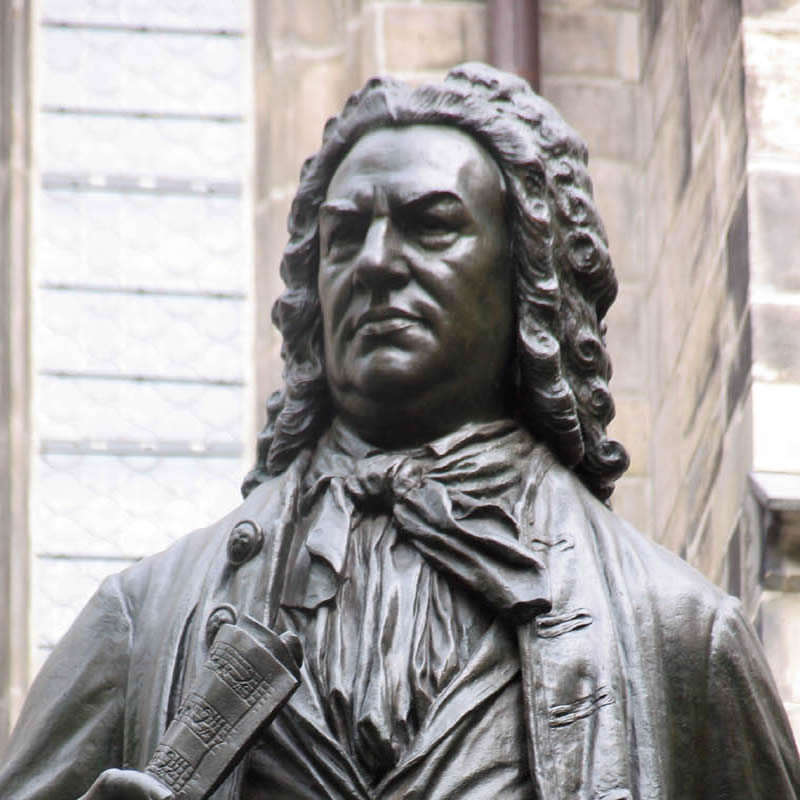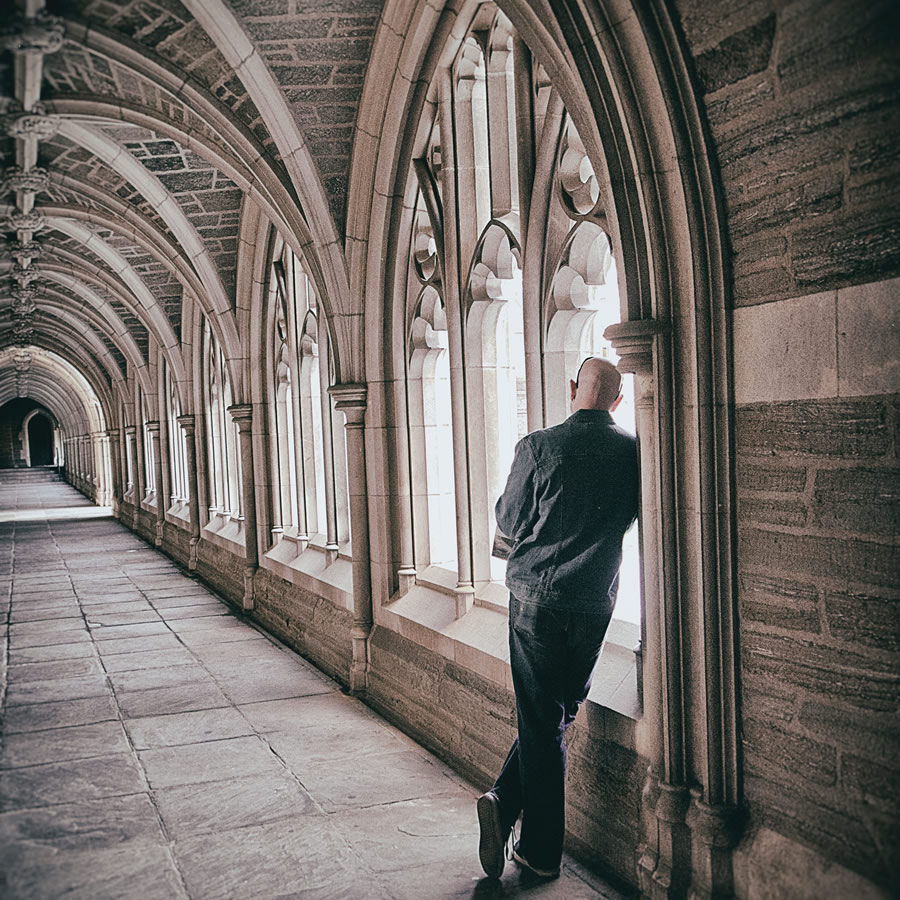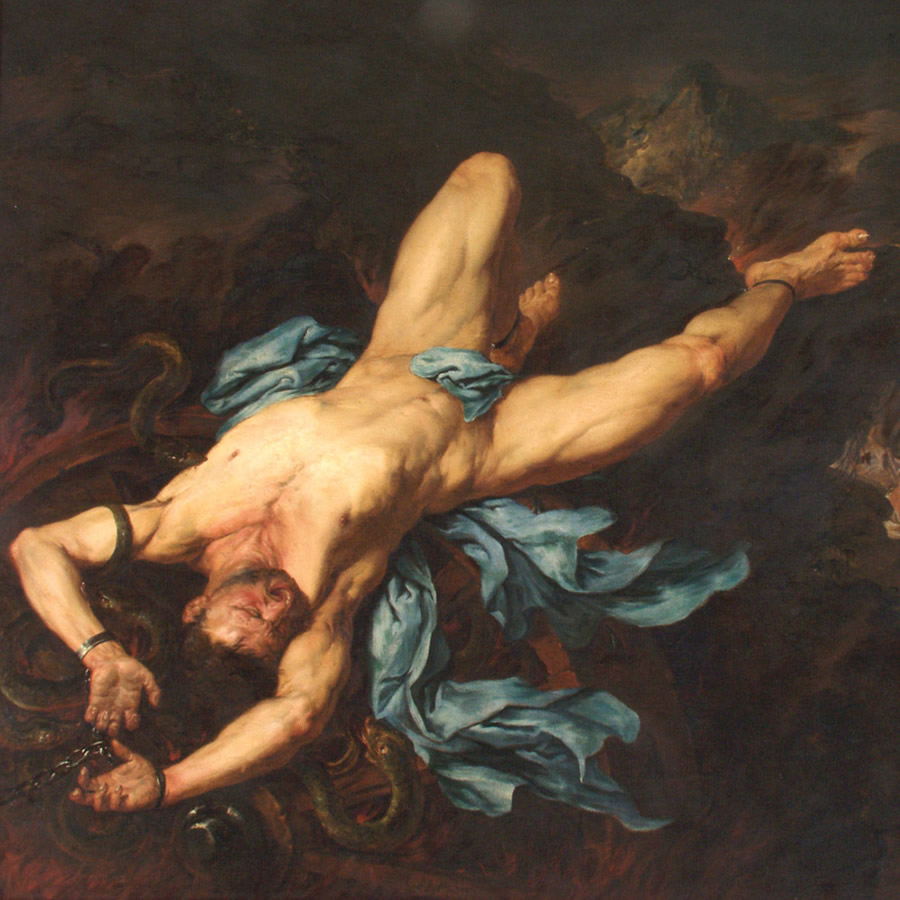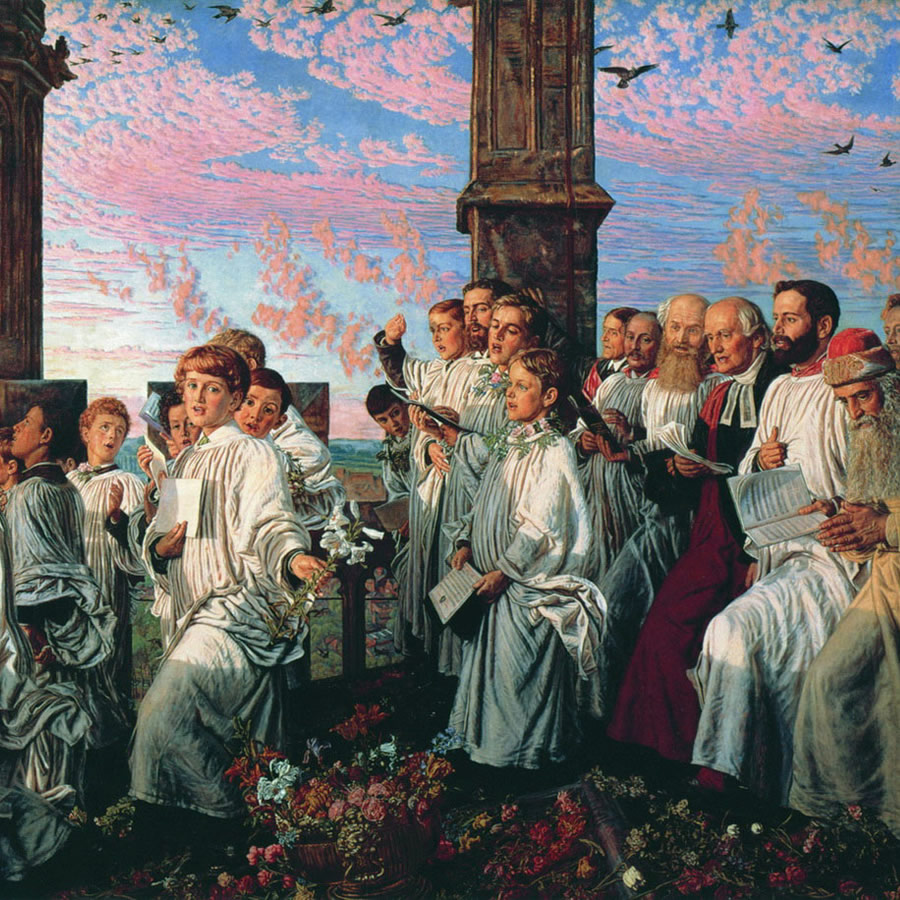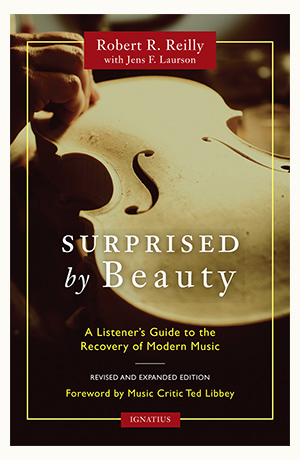EDITOR’S NOTE: Sir Roger Scruton was invited to the prestigious Donaueschingen Festival, at the very heart of music’s avant-garde movement, where he delivered this lecture in October 2016. We think it may be of interest to the many people who have been following our sometimes controversial series on the Darmstadt School’s role in undermining contemporary composition and diminishing our audiences. It is printed here with the gracious permission of the author.
Important composers, from Schoenberg and Stravinsky to Ligeti and Stockhausen, have been premiered in this place and before this audience. Along with Darmstadt, Donaueschingen has helped to restore Germany to the central place in European musical culture that it has occupied in the past and will always deserve. Now, in its latest and securest phase as the Musiktage, the Donaueschingen festival has become a symbol of musical modernism, and it is a great honour to be invited to speak from this podium to one of the most educated musical audiences in the world today. But in this short talk I will try to outline why I question the prominence in our musical culture of the experimental avant-garde.
In 1860 Wagner published a now famous pamphlet entitled The Music of the Future – Zukunftmusik. In it he expressed his view that it was not enough for music to be merely contemporary – zeitgenössisch; it had to be ahead of itself, summoning from the future the forms that already lay there in embryo. And of course Wagner was entitled to write in this way, given what he had achieved in Tristan und Isolde, which was finished the year before his essay appeared, and which introduced the chromatic syntax that was to change the course of musical history.
We should not forget, however, the wider context of Wagner’s argument. The obsession with the future comes from Ludwig Feuerbach, and ultimately from Hegel’s philosophy of history, which represents human events as motivated by the always-advancing logic of the dialectic. For Hegel history has a direction, and this direction is revealed in laws, institutions, and sciences, as well as in literature, art, and music. Each period is characterised by its Zeitgeist, shared among all the products of the culture.
In Feuerbach the Zeitgeist idea is allied to the belief in progress, understood in terms of the life and energy of human communities. The future, Feuerbach believed, is not merely a development of the past; it is better than the past. It marks an increase in knowledge and therefore in power over our own destiny and therefore in freedom. It is not easy now, after the communist and fascist experiments, to endorse the belief in progress that they both so vehemently shared. But somehow, in the arts, the belief survives. We spontaneously incline to the view that each artistic form and style must be superseded as soon as it appears, and that the true values of art require constant vigilance against the diseases of nostalgia and pastiche. Each composer faces the challenge: why should I listen to you? And each claims originality, authenticity, the plain fact of being me, as a vindication. Hence each tries to avoid repeating what has been done already or relying on formulae that, by dint of over-use, have become clichés. In everyday life clichés may be useful, since they evoke stock reactions and settled beliefs. In art, however, clichés are inherently meaningless, since they place mechanical reactions where real inspiration should be.
Wagner’s emphasis on the future of music was influenced by the Hegelian theory of history and Feuerbach’s use of it. But it was also rooted in a real sense of tradition and what tradition means. His innovations grew organically from the flow of Western music, and his harmonic discoveries were discoveries only because they also affirmed the basic chord-grammar of diatonic tonality. They were discoveries within the extended tonal language. Wagner was aware of this, and indeed dramatized the predicament of the modern composer in Die Meistersinger von Nürnberg, which is his own striking reflection on ‘tradition and the individual talent.’ In that opera the plodding C major tonality of the Mastersingers is brought to life, not by remaking it entirely, but by moving it onwards, through the use of chromatic voice-leading, altered chords and a new kind of melody in which boundaries are fluid and phrases can be repeated and varied at liberty within them. In the course of the opera the chorus brings the new melody and the old harmony into creative relation, and the work ends jubilantly, with the new incorporated and the old renewed. This is nothing like the radical avant-garde departures that have dominated music in more recent times.
Right up until Schoenberg’s experiments with serialism, musical innovation in the realm of ‘classical’ music proceeded in Wagner’s way. New harmonies, scales, and melodic ensembles were imported into the traditional musical grammar, new rhythms and time-signatures were adopted, and with Stravinsky and Bartók organisation was inspired more by dance than by the classical forms. Debussy’s use of the whole tone scale, and Rimsky-Korsakov’s introduction of the octatonic scale led to music in which, while there was melodic and harmonic progression, there was often no clear tonic, or two competing tonics, as in much of the Rite of Spring. Schoenberg wrote of ‘floating tonality,’ others of atonality, meaning the loss of the sense of key, and the use of harmonies which, even if tied to each other by voice-leading, seemed to be unrelated and, by the old standards, ungrammatical.
None of that involved any rejection of the classical tradition: composers like Debussy, Bartók, and Stravinsky were renewing that tradition, and what they wrote was not merely recognizable to the ordinary educated listener, but also interesting and challenging on account of its new harmonic, melodic, and rhythmical devices. Both the continuous development of the romantic symphony in Sibelius, Vaughan Williams, and Shostakovich, and the incorporation of modernist devices into the tonal language, lay within the scope of the existing language: these were developments that issued naturally from the pattern of musical discovery that has characterised Western classical music from the Renaissance.
As things stand now, however, there is absolutely no guarantee that a new work of music will be recognized as such by the educated musical ear, or that it will be possible to hear it as an addition to the great tradition of symphonic sound. A radical break seems to have occurred, with two consequences that the listening public find difficult to absorb: first, modern works of music tend to be self-consciously part of an avant-garde, never content to belong to the tradition but always overtly and ostentatiously defying it; second, these works seem to be melodically impoverished, and even without melody entirely, relying on sound effects and acoustical experiments to fill the void where melody should be. I don’t say the emphasis on acoustics is necessarily a fault from the artistic point of view. I draw your attention to the example we heard yesterday, when Nathan Davies used live filtering to give the effect of resonators, extracting tones from white noise, and turning those tones towards music. The effect was undeniably striking, at times entrancing: as though the tones were being purified so that they can be used as though new. But until those tones are used, and used in melodic and harmonic structures, the result will remain at a distance from the audience, outside the reach of our musical affections. It is only the loved and repeated repertoire that will ensure the survival of music, and to be loved and repeated music requires a dedicated audience. Music exists in the ear of the listener, not on the page of the score, nor in the world of pure sound effects. And listeners, deterred by the avant-garde, are in ever-shorter supply: not in Donaueschingen, of course, but in the wider culture of our cities, where music will survive or die.
I identify four developments that have led to the place where we now are. Thanks to these developments a new kind of music has emerged which is less music than a reflection upon music, or perhaps even a reflection on the lack of music, or on the impossibility of music in the age in which we live.
The first development is, in many ways, the most interesting from the philosophical point of view, and this is the radical attack on tonality by Theodor Adorno and his immediate followers. Although Adorno linked his argument to his advocacy of Schoenberg’s twelve-tone serialism, the force of the argument is largely negative. It concerned what he was against, rather than what he was for. And Adorno’s argument carried weight in the post-war period because he was an ardent critic of the culture of capitalism, one who had attempted to adapt the Marxist critique of bourgeois society to the new social and political realities. Adorno’s critique of tonality was part of a systematic theory of the death of bourgeois culture. Tonality had to die because the bourgeois order had to die. And the desire nevertheless to cling to tonality, in the manner of Sibelius or Copland, even in the manner of the neo-classical Stravinsky, is bound to lead, Adorno thought, to empty clichés or sterile kitsch. Such is the inevitable result of attempting to make use of an idiom that has died.
This argument of Adorno’s, which is an application of the Hegelian Zeitgeist theory, is not easily answered, even if it is easily doubted. All artistic people are aware that styles, idioms and forms are living things that can also die, and that there is a need, integral to the artistic enterprise as such, to ‘make it new.’ This does not mean being iconoclastic or radical in the manner of the modernist avant-garde. It means conveying a message and an inspiration of one’s own. The true work of art says something new, and is never a patchwork of things already said. This is the case even when the work employs an idiom already perfected by others, as when Mozart, in his string quartets, writes in the language of Haydn.
Thomas Mann wrote a great novel about this, Doktor Faustus, meditating on the fate of Germany in the last century. Mann takes the tradition of tonal music as both a significant part of our civilisation, and a symbol of its ultimate meaning. Music is the Faustian art par excellence, the defiant assertion of the human voice in a cosmos of unknowable silence. Mann therefore connects the death of the old musical language with the death of European civilisation. And he re-imagines the invention of twelve-tone serialism as a kind of demonic response to the ensuing sense of loss. Music is to be annihilated, re-made as the negation of itself. The composer Adrian Leverkühn, in the grip of demonic possession, sets out to ‘take back the Ninth Symphony.’ Such is the task that Mann proposes to his devil-possessed composer, and one can be forgiven for thinking that there are composers around today who have made this task their own.
This brings me to the second development that has fed into the obsession with the avant-garde, and that is the invention of serialism. I call this an invention, rather than a discovery, in order to record the wholly a priori nature of the serial system. The new harmonies and chromatic melodies of Tristan were discoveries: musical events that came into being by experiment, and were adopted because they sounded right. In retrospect you can give quasi-mathematical accounts of what Wagner was doing in the first bars of Tristan. But you can be sure that you will not thereby be identifying Wagner’s own creative process, which was one of trying out new combinations and seeing where they lead.
By contrast, serial organisation was an invention – a set of a priori rules laid down by Schoenberg and adapted and varied by his successors. These rules were to provide a non-tonal grammar for music, determining what comes next independently of whether its coming next sounds right or wrong to the normal musical ear. It is not the tone or the scale but the maths that matters. There is no reason, of course, to think that serial organization should not also lead to sequences that do sound right, or come to sound right in time. But their sounding right is quite independent of the serial organisation.
One of the advantages of working with a framework of a priori rules is that you can say just why this note occurs in just this place: the series requires it. But in another sense you lack such an answer, since the series requires the note regardless of the heard relation to its predecessor. Moreover the grammar of serialism is not based on the scale or any other way of grouping tones dynamically, in terms of what leads to what. A series is the basis for permutations, not linear movements. In listening to music, however, we listen out for progression, prolongation, question and answer – all the many ways in which one tone summons another as its natural successor. Serialism asks us to hear in another way, with the brain rather than the ear in charge.
The result of this is that, while we can enjoy and be moved by serial compositions, this is largely because we hear them as organised as tonal music is organized, so that ‘next’ sounds ‘right.’ We may notice the serial structure; but it is the progressive, linear structure that we enjoy. In a great serial composition, such as the Berg Violin Concerto, we hear harmonies, melodies, sequences, and rhythmical regularities, just as in the great works of the tonal tradition, and we do so because we are hearing against the serial order. It is as though the composer, having bound himself in chains, is able nevertheless to dance in them, like a captive bear.
The third development, associated particularly with Boulez, Stockhausen, and Nono, is the move towards total serialisation. Composers decided to serialise time values, unpitched sounds, and timbres, hoping thereby to exert total control over everything. Interestingly enough this development went hand in hand with the emergence of aleatoric scores, in which instrumentalists are handed bundles of notes that they could choose to assemble in any order, or scores which ask for indeterminate sounds. Randomisation had the same effect as serialisation, which was to deprive musical elements of their intrinsic ways of relating to each other. Whether we impose a dictatorial serial order, or present notes in unordered bundles, we undo the demands of melody, harmony and rhythm, which are inherent in the traditional grammar, and replace them with systematic requirements that can be explained intellectually but not, as a rule, heard musically.
In 1970 Stockhausen composed a two-piano piece, Mantra, for this festival. In a subsequent lecture delivered in Britain, which can be seen on YouTube, he sets out the twelve-tone series on which the piece is based. He plays the notes one after another, assigning an equal time-value to each, and tells us that this melody occurred to him at a certain point, and that he decided to work on it, composing flights of new notes around each of its elements, arranging the series in conjunction with its own retrograde, and so on. What was most striking to me about Stockhausen’s description of what he was doing was the word ‘melody,’ used of this sequence that is not a melody at all. Of course there are twelve-tone melodies – for example the beautiful melody that Berg assigns to his destructive heroine Lulu in the opera of that name. But all that makes sequences into melodies is absent from Stockhausen’s theme: it has no beginning, no end, no up-beat, no tension or release, no real contour apart from its pure geometrical outline. It is a musical object, but not a musical subject. And as he explains what is done with it you understand that it is treated as an object too – a piece of dead tissue to be cut up beneath the microscope. We understand the distinction between subject and object because we ourselves exemplify it. The true musical theme is a subject in something like the sense that I am a subject: it has a consciousness of itself, a meaning and a point of view. This is simply not true of the helpless dead sequence that Stockhausen presents us in his lecture.
The effect of such innovations was to replace the experience of music by the concept of music. The typical avant-garde work is designed as the concept of itself, and often given some portentous title by way of illustrating the point, like Stockhausen’s Gruppen: a work for three orchestras in which notes are amalgamated into groups according to their acoustical properties, and tempos are defined logarithmically. Much can be said, and has been said, about this momentous, not to say megalomaniac, composition, and indeed its great success, like that of Boulez’s Le marteau sans maître, is not independent of the fact that there is so much to say about it, some of which Stockhausen himself had anticipated in his article ‘wie die Zeit vergeht..’, published in the third issue of Die Reihe. The score is not a notation of musically organized sounds, but a mathematical proof, from which the sounds can be deduced as theorems.
The eclipse of art by the concept of art occurred at around the same time in the visual arts, and for a while the game was amusing and intriguing. However, this particular bid for originality has dated much more rapidly than any of the harmonic discoveries of the late romantics. Do it once, and you have done it for all time. This is certainly what we have seen in the realm of conceptual art in our museums and galleries. And it is what we have heard in the concert hall too. In conceptual music the creative act is always, from the musical point of view, the same, namely the act of putting an idea about music in the place where music should be.
This leads me to the fourth development, which is in many ways the most interesting, namely the replacement of tones by sounds, and musical by acoustical hearing. Varèse, Pierre Schaeffer and their immediate successors awoke composers and audiences to the many new sounds, some of them produced electronically, that could enter the space of music without destroying its intrinsic order. These experiments are not what I have in mind when referring to the replacement of tones by sounds and musical by acoustical hearing. I am thinking of a more general transition, from Tonkunst to Klangkunst, to use the German expressions – a transition of deep philosophical significance, between two ways of hearing, and two responses to what is heard.
Sounds are objects in the physical world, albeit objects of a special kind whose nature and identity is bound up with the way they are perceived. Tones are what we hear in sounds when we hear the sounds as music. They have features that no sound can possess – such as movement, gravitational attraction, weight, and position in a one-dimensional space. They exemplify a special kind of organisation – an organisation that we hear and which exists only for someone who can hear it. (Someone might be an expert at hearing pitched sounds, and may even be gifted with absolute pitch, but still be ‘tone deaf,’ since unable to hear the musical organisation. Sequences don’t sound right to such a person, because they never sound wrong.)
The object of musical hearing is organised by metaphors of space and movement that correspond to no material realities. Music goes up and down, it leads and follows; it is dense, translucent, heavy, light; it encounters obstacles and crashes through them, and sometimes it comes to an end which is the end of everything. Those metaphors, and the order derived from them, are shared by all musical people. The order that we hear is an order that we – the musical public – hear, when we hear these sounds as music. And although there is, at any moment, an indefinite number of ways in which a melodic line or a chord sequence can continue without sounding wrong, the ideal in our tradition has been of an uninterrupted sense of necessity – each melodic and harmonic step following as though by logic from its predecessor, and yet with complete freedom.
When we hear tones we are also hearing sounds; but we are hearing in those sounds movement, organisation and gravitational forces in a one-dimensional musical space. That is the fundamental musical experience, the experience that causes us to hear one note as moving on from another, answering another, attracted to or repelled by another. It is what enables us to hear tension and release, beginnings and endings, goals and starting points. It is at the root of the art of music as we have known it, since it is what gives music its fundamental nature as an art of motion, which grips us and takes us with it in a space of its own. We are moved by music because music moves.
Of course there are sound effects too: sounds from the real world intrude into music, like the unpitched sounds of the percussion section, or the recorded bird-song that intrudes into Respighi’s Pines of Rome. But when we hear these sounds as part of the music they change character. They are no long noises, no longer events in the ambient soundscape, like the coughs from the audience on a cold winter’s day. They are caught up in the musical movement, becoming one with it, and dependent on the forward propulsion of which they are now a part. Thus a single piece of music, with no repeats, may nevertheless contain multiply repeated sequences of sounds. As objects in the material world sounds are identified and counted in another way from the way in which melodies, which are intentional and not material objects, are counted.
The intrusion of acoustical ways of thinking into the practice and teaching of music is something we owe to Boulez and Stockhausen, and to the educational practises that they established. In Stockhausen sounds from everyday life are accorded exactly the same value as sounds within music – they are, as it were, invited in from the surrounding world, as in the work Momente, in which all kinds of sounds and speech-forms are brought together in a potpourri of fragments. As Stockhausen himself says, this work has no real beginning and no end: like all his works it starts without beginning and finishes without ending. For it lacks those elements of musical grammar that make beginnings and endings perceivable. It starts nowhere and stays at nowhere until ending nowhere. The same is true of Boulez’s Pli selon pli, in which the exotic instrumentation and serial organisation do not conceal the fact that no moment in this work has any intrinsic connection to the moment that comes next. The experience of ‘next,’ and the inevitability of the next, has been chased away. In a concert devoted to music of this kind the audience can know that the piece is ended only because the performers are putting down their instruments.
Music (music of our classical tradition included) has until now consisted of events that grow organically from each other, over a repeated measure and according to recognizable harmonic sequences. The ‘moving forward’ of melodic lines through musical space is the true origin of musical unity and of the dramatic power of traditional music. And it is this ‘moving forward’ that is the first casualty when pitches and tempi are organised serially, and when sounds are invited in from outside the music. Add the acoustical laboratory and the result is all too often heard as arbitrary – something to be deciphered, rather than something to be absorbed and enjoyed in the manner of a conversation.
This is not to say that acoustical processing may not have a part, and an important part, to play in bringing sounds into a musical structure. Joanna Bailie, to take just one example, has used the recorded and digitally processed sounds culled in public spaces as inputs into music for which instrumentalists and singers create the musical frame. The atmospheric effect of this was heard here in Donaueschingen a day ago. However, in the work of such composers we see the reassertion of the musical against the acoustical ear, and perhaps even a path back to the place where music reigns in a space of its own.
All those four developments are of the greatest musicological interest, and I do not deny that they can be used effectively, to produce works of real musical power. But it is also clear to my way of thinking that they are responsible for a growing gap between serious music and the audience on which it depends, not necessarily financially (since after all there is a massive machinery of subsidy that keeps the avant-garde in business), but at least spiritually. If avant-garde music is ever to step down from the world of concepts into the world of tones, then it will be because the audience exists in whose ears this transition can occur. Take away the audience and you take away the concrete reality of music as an art. You turn music into an arcane exercise in the acoustical laboratory, in which groups of patient instrumentalists pump out sounds according to formulae which mean nothing, since meaning lies in the ears that have fled from the scene. Of course, not here in Donaueschingen, where the distinctive physiognomy of the avant-garde ear is very apparent all around us.
It is not enough to say that, of course. Adorno may have been right that the old grammar was exhausted, that post-romantic harmony had taken tonality as far as it could go, and that music must therefore find another way into the future, whether or not led by the avant-garde. The great question that we must still confront is whether rhythm, melody, and harmony are still available to us, in whatever modified forms, as we endeavour to write music that will be not only interesting, as so much avant-garde music undeniably is, but also enjoyable and calling out for repetition. We all know Schoenberg’s remark, that there is plenty of music still to be written in C major. But where is that music? Or rather, where is that way of writing, downstream from C major, that will restore to C major its undeniable authority for all of us, as it was restored by the final chords of Die Meistersinger?
Two aspects of modern culture place obstacles in front of us, as we search for the new idiom that will renew our musical tradition. One is the insistent presence of easy music; the other is the dictatorship exerted on behalf of difficult music. By easy music I mean the ubiquitous products of pop and rock, which influence the ears and the attention-span of young people long before they can be captured by a teacher. The audience for new music must be discovered among young people whose ears have been shaped by the ostinato rhythms and undemanding chord-grammar of pop. To offer serious music to such an audience you must also attract their attention. And this cannot be done without rhythms that connect to their own bodily perceptions. Serious composers must work on the rhythms of everyday life. Bach addressed listeners whose ears had been shaped by allemandes, gigues, and sarabands – dance rhythms that open the way to melodic and harmonic invention. The modern composer has no such luck. The 4/4 ostinato is everywhere around us, and its effect on the soul, body, and ear of post-modern people is both enormous and unpredictable. Modern composers have no choice but to acknowledge this, if they are to address young audiences and capture their attention. And the great question is how it can be done without lapsing into banality, as Adorno told us it must.
Americans tend to accept popular music and the culture around it, as providing the raw material on which the serious composer gets to work. From Gershwin to John Adams it has been normal to take some aspect of the popular music of the day and to show its connection to other and more long-term ways of musical thinking. Just as Gershwin rewrote jazz sequences in the language of counterpoint, so does Adams lift the ostinato four in a bar of the Rock group into an orchestral empyrean, where the flat-footed dance gives way to a gravitationless rhythm that moves and develops with the harmony. Adams uses the tonal language, not to make the kind of profound statement of a Beethoven or a Bruckner, but nevertheless to lift the young ear out of its groove and to make it listen. There is a lesson to be taken from this, which is that music is tested in the ear of the listener and not in the laboratory, and the ear of the listener is plastic, moulded both by the surrounding culture and by the everyday sounds of life as it is now. In a way Stockhausen acknowledged this, with his works that snatch sounds from the surrounding world, and work them into his quasi-mathematical textures. But the textures are feeble, with no musical propulsion, no intrinsic ‘next’ to bind one event to its neighbours. Adams wished to provide that propulsion, into which the sounds of the modern world could be dropped and immediately reshaped as music. But maybe there is something mechanical here too – an ostinato that uses rhythmic pulse to carry us through whatever harmonic and melodic weaknesses we might otherwise hear in the score.
The contrary obstacle also lies before us: the dictatorship of the difficult. Bureaucrats charged with giving support to the arts are, today, frightened of being accused of being reactionary. I suspect that everyone in this room is frightened of being accused of being reactionary. The history of the French salons in the 19th century, and of the early reactions to musical and literary modernism, has made people aware of how easy it is to miss the true creative product, and to exalt the dead and the derivative in its stead. The safest procedure for the anxious bureaucrat is to subsidize music that is difficult, unlikely to be popular, even repugnant to the ordinary musical ear. Then one is sure to be praised for one’s advanced taste and up-to-date understanding. Besides, if a work of music is easy to assimilate and clearly destined to be popular it does not need a subsidy in any case.
It is surely in this way that Boulez rose to such an eminence in France. In a book published in 1995: Requiem pour une avant-garde, Benoît Duteurtre tells the story of the steady takeover by Boulez and his entourage of the channels of musical and cultural communication, and their way of establishing a dictatorship of the difficult at the heart of the subsidy machine. At the same time as vilifying his opponents and anathematising tonal music and its late offshoots in Duruflé and Dutilleux, Boulez achieved a cultural coup d’état, which was the founding of IRCAM. This institution, created by and for him at the request of President Pompidou in 1970 reveals in its name – Institut de Recherche et Coordination Acoustique/Musique – that it does not distinguish between sound and tone, between Klangkunst and Tonkunst, and sees both as matters for ‘research.’ Maintained by government funds in the basement of its architectural equivalent, the Centre Pompidou, and absorbing a substantial proportion of a budget that might have been used to sustain the provincial orchestras of France, IRCAM has produced a stream of works without survival value. Despite all Boulez’s efforts, musical people still believe, and rightly, that the test of a work of music is how it sounds, not how it is theorized. But only if it sounds difficult, disturbing, ‘challenging,’ ‘transgressive’ could a bureaucrat dare to provide it with a subsidy.
And this is why it is good that this festival exists. Even if it depends on the support of state institutions, it is also addressed to the musical public: it is an invitation to people to make their feelings known, and to make judgments for themselves – which is what I have been doing. It has played a part in exposing the avant-garde to judgment, and also in giving opportunities to young musicians to wrestle with difficult music and to find what inspired it. This place is testimony to the crucial relation between the work of music and its audience. It is proof that there can be an avant-garde in music only if there is an avant-garde audience to listen to it. Whatever the results, you are that audience and far more practised at stretching your ears in new directions than I am. I only wonder whether you might, from time to time, entertain the thought that one can be modern without being avant-garde, without lapsing into sound effects, and instead thinking in the old musical way, in terms of grammatical sequences, with a beginning, a middle and an end, sequences that linger in the ears and the memory of the listeners, so that even if they never hear the piece again, they sing it to themselves inwardly and find in it a personal meaning. It seems to me that, if there is, now, to be a music of the future it will, in that way, belong with the music of the past.
